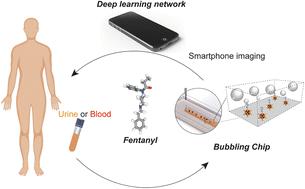Our official English website, www.x-mol.net, welcomes your
feedback! (Note: you will need to create a separate account there.)
Deep learning-assisted sensitive detection of fentanyl using a bubbling-microchip
Lab on a Chip ( IF 6.1 ) Pub Date : 2022-10-31 , DOI: 10.1039/d2lc00478j Hui Chen 1 , Sungwan Kim 1 , Joseph Michael Hardie 1 , Prudhvi Thirumalaraju 1 , Supriya Gharpure 1 , Sahar Rostamian 1 , Srisruthi Udayakumar 1 , Qingsong Lei 1 , Giwon Cho 1 , Manoj Kumar Kanakasabapathy 1 , Hadi Shafiee 1
Lab on a Chip ( IF 6.1 ) Pub Date : 2022-10-31 , DOI: 10.1039/d2lc00478j Hui Chen 1 , Sungwan Kim 1 , Joseph Michael Hardie 1 , Prudhvi Thirumalaraju 1 , Supriya Gharpure 1 , Sahar Rostamian 1 , Srisruthi Udayakumar 1 , Qingsong Lei 1 , Giwon Cho 1 , Manoj Kumar Kanakasabapathy 1 , Hadi Shafiee 1
Affiliation

|
Deep learning-enabled smartphone-based image processing has significant advantages in the development of point-of-care diagnostics. Conventionally, most deep-learning applications require task specific large scale expertly annotated datasets. Therefore, these algorithms are oftentimes limited only to applications that have large retrospective datasets available for network development. Here, we report the possibility of utilizing adversarial neural networks to overcome this challenge by expanding the utility of non-specific data for the development of deep learning models. As a clinical model, we report the detection of fentanyl, a small molecular weight drug that is a type of opioid, at the point-of-care using a deep-learning empowered smartphone assay. We used the catalytic property of platinum nanoparticles (PtNPs) in a smartphone-enabled microchip bubbling assay to achieve high analytical sensitivity (detecting fentanyl at concentrations as low as 0.23 ng mL−1 in phosphate buffered saline (PBS), 0.43 ng mL−1 in human serum and 0.64 ng mL−1 in artificial human urine). Image-based inferences were made by our adversarial-based SPyDERMAN network that was developed using a limited dataset of 104 smartphone images of microchips with bubble signals from tests performed with known fentanyl concentrations and using our retrospective library of 17 573 non-specific bubbling-microchip images. The accuracy (± standard error of mean) of the developed system in determining the presence of fentanyl, when using a cutoff concentration of 1 ng mL−1, was 93 ± 0% in human serum (n = 100) and 95.3 ± 1.5% in artificial human urine (n = 100).
中文翻译:

使用起泡微芯片深度学习辅助敏感检测芬太尼
支持深度学习的基于智能手机的图像处理在护理点诊断的开发中具有显着的优势。传统上,大多数深度学习应用程序都需要特定于任务的大规模专业注释数据集。因此,这些算法通常仅限于具有可用于网络开发的大型回顾数据集的应用程序。在这里,我们报告了利用对抗性神经网络通过扩展非特定数据在深度学习模型开发中的效用来克服这一挑战的可能性。作为临床模型,我们报告了使用深度学习支持的智能手机检测在护理点检测芬太尼(一种小分子量药物,属于阿片类药物的一种)。我们在支持智能手机的微芯片鼓泡测定中利用铂纳米颗粒 (PtNP) 的催化特性,以实现高分析灵敏度(检测磷酸盐缓冲盐水 (PBS)、0.43 ng mL -1中浓度低至 0.23 ng mL -1的芬太尼人血清中0.64 ng mL -1人造尿中)。基于图像的推论是由我们基于对抗性的 SPyDERMAN 网络进行的,该网络是使用 104 张智能手机微芯片图像的有限数据集进行开发的,这些微芯片的气泡信号来自使用已知芬太尼浓度进行的测试,并使用我们的 17 573 个非特定气泡微芯片的回顾性库图片。当使用 1 ng mL -1的截止浓度时,所开发系统确定芬太尼存在的准确度(±平均值标准误差)在人血清 ( n = 100)中为 93 ± 0% ,在人血清中为 95.3 ± 1.5%人造人尿液中(n = 100)。
更新日期:2022-11-04
中文翻译:

使用起泡微芯片深度学习辅助敏感检测芬太尼
支持深度学习的基于智能手机的图像处理在护理点诊断的开发中具有显着的优势。传统上,大多数深度学习应用程序都需要特定于任务的大规模专业注释数据集。因此,这些算法通常仅限于具有可用于网络开发的大型回顾数据集的应用程序。在这里,我们报告了利用对抗性神经网络通过扩展非特定数据在深度学习模型开发中的效用来克服这一挑战的可能性。作为临床模型,我们报告了使用深度学习支持的智能手机检测在护理点检测芬太尼(一种小分子量药物,属于阿片类药物的一种)。我们在支持智能手机的微芯片鼓泡测定中利用铂纳米颗粒 (PtNP) 的催化特性,以实现高分析灵敏度(检测磷酸盐缓冲盐水 (PBS)、0.43 ng mL -1中浓度低至 0.23 ng mL -1的芬太尼人血清中0.64 ng mL -1人造尿中)。基于图像的推论是由我们基于对抗性的 SPyDERMAN 网络进行的,该网络是使用 104 张智能手机微芯片图像的有限数据集进行开发的,这些微芯片的气泡信号来自使用已知芬太尼浓度进行的测试,并使用我们的 17 573 个非特定气泡微芯片的回顾性库图片。当使用 1 ng mL -1的截止浓度时,所开发系统确定芬太尼存在的准确度(±平均值标准误差)在人血清 ( n = 100)中为 93 ± 0% ,在人血清中为 95.3 ± 1.5%人造人尿液中(n = 100)。











































 京公网安备 11010802027423号
京公网安备 11010802027423号